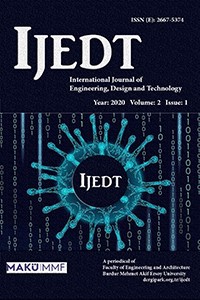Abstract
The internship is an educational method that aims to increase the professional awareness of the students in addition to the knowledge they gain during their theoretical, conceptual, and practical courses. Many disciplines consider an internship as a compulsory requirement for graduation. The same rule applies to interior architecture, which is about converting theoretical knowledge into practice. Evaluating the internship guidelines of 53 Bachelor Programs of Interior Architecture in Turkey indicates two distinctive internships as construction and office one. Besides, some universities require other internships such as workshops, measured drawing training or technical-trip training. Although internship promotes technical and social skills and foster professional knowledge of interior architecture students, occasionally there might be challenges on the submission of the application, finding a place for an internship or miscommunication of interns and employees. In this respect, this study has intended to learn the strengths and weaknesses of internship in interior architecture programs in Turkey. Using a questionnaire survey for both interior architects’ employer and interior architecture students, this research comes up with some recommenda-tions to overcome the so called related challenges for interior architecture internships.
Keywords
Interior architecture education professional internship compulsory internship internship practice
References
- Fitoz , İ. (2015). Interior design education programs during historical periods. Procedia - Social and Behavioral Sciences 174: 4122-4129.
- Gordon, G.G, Hage, H.H. & McBride. R.B. (2001). Criminal Justice Internship: Theory into Practice, Fourth Edition. Cincinnati, Ohio: Anderson Publishing.
- Gündeş, S., Atakul, N. (2017). An empirical study of internship practices in architectural education: Student perspectives. MEGARON / Yıldız Technical University, Faculty of Architecture 12 (3): 355-364.
- Jackson, D. (2014). Employability skill development in work-integrated learning: Barriers and best practice, Studies in Higher Education 40 (2): 350-367.
- Kanoğlu, A., Yazıcıoğlu, A.D. (2014). Mimarlık ve iç mimarlık eğitiminde zorunlu staj sisteminin yeniden yapılandırılmasına yönelik bir model, 6. Uluslararası Eğitim Araştırmaları Kongresi, 05-08 Haziran 2014, Ankara, Turkey.
- Karaman A., Güven Ş., Yıldırım M. N., (2018). İç mekan tasarımı öğrencilerin yaz stajı hakkındaki görüşlerin incelenmesi: Uşak Üniversitesi örneği. The Journal of Academic Social Science 6 (66): 93-107.
- Özker, S. (2018). In the context of universities in Turkey; analysis of academic programs for the department of interior architecture. Procedia - Social and Behavioral Sciences 152: 31-40.
- Pasewark, W. R. (1989). An empiricale of the effect of previous internship experience on interviewing success, Journal of Accounting Education 7(1): 25-39.
- Ross, L. E., Elechi, O. O. (2002). Student attitudes towards internship experiences: from theory to practice, Journal of Criminal Justice Education13 (2): 297-312.
- Shannon, J. S. (2012). I wish for more than I ever get: employers’ perspectives on employability attributes of architecture graduates. Creative Education 3 (Special Issue): 1016-1023.
- Taylor, D. (1999). Jumpstarting Your Career: An Internship Guide for Criminal Justice. New Jersey: Prentice Hall.
Abstract
Staj, öğrencilerin eğitim-öğretim dönemlerinde almış oldukları kuramsal, teorik ve uygulamalı derslerdeki bilgilerin pratik yapılarak, mesleki farkındalığın artırılmasını amaçlayan bir eğitim yöntemidir. Pek çok meslek grubunun lisans mezuniyet koşulları içerisinde bulunan staj uygulaması, teorik bilginin pratiğe dönüştürüldüğü içmimarlık mesleği eğitiminde de önemli yer tutmak-tadır. Türkiye’de eğitim-öğretime başlamış olan 53 tane içmimarlık bölümünün staj yönergeleri incelendiğinde, staj uygulamasının genel olarak ofis ve şantiye stajı olmak üzere ikiye ayrılmış olduğu, bazı üniversitelerde ise buna ek olarak, atölye, rölöve, teknik gezi gibi stajların mevcut olduğu görülmektedir. İçmimarlık öğrencileri için teknik ve sosyal anlamda birçok beceri ve fırsatı yanında getiren stajın, uygulanmasında, staj yeri bulunması, işveren ya da öğrencinin tutumlarında zaman zaman aksaklıklar yaşanabilmektedir. Bu bağlamda, staj uygulamasının güçlü ve zayıf yönlerinin belirlenmesi amacıyla, içmimarlık öğrencileri ve içmimar işverenlere anket uygulanmış, uygulanan bu anket sonuçları değerlendirilerek, varılan sonuçlar doğrultusunda önerilerde bulunulmuştur.
Thanks
Araştırmamıza destek olan TMMOB İçmimarlar Odası üyelerine teşekkürü bir borç biliriz.
References
- Fitoz , İ. (2015). Interior design education programs during historical periods. Procedia - Social and Behavioral Sciences 174: 4122-4129.
- Gordon, G.G, Hage, H.H. & McBride. R.B. (2001). Criminal Justice Internship: Theory into Practice, Fourth Edition. Cincinnati, Ohio: Anderson Publishing.
- Gündeş, S., Atakul, N. (2017). An empirical study of internship practices in architectural education: Student perspectives. MEGARON / Yıldız Technical University, Faculty of Architecture 12 (3): 355-364.
- Jackson, D. (2014). Employability skill development in work-integrated learning: Barriers and best practice, Studies in Higher Education 40 (2): 350-367.
- Kanoğlu, A., Yazıcıoğlu, A.D. (2014). Mimarlık ve iç mimarlık eğitiminde zorunlu staj sisteminin yeniden yapılandırılmasına yönelik bir model, 6. Uluslararası Eğitim Araştırmaları Kongresi, 05-08 Haziran 2014, Ankara, Turkey.
- Karaman A., Güven Ş., Yıldırım M. N., (2018). İç mekan tasarımı öğrencilerin yaz stajı hakkındaki görüşlerin incelenmesi: Uşak Üniversitesi örneği. The Journal of Academic Social Science 6 (66): 93-107.
- Özker, S. (2018). In the context of universities in Turkey; analysis of academic programs for the department of interior architecture. Procedia - Social and Behavioral Sciences 152: 31-40.
- Pasewark, W. R. (1989). An empiricale of the effect of previous internship experience on interviewing success, Journal of Accounting Education 7(1): 25-39.
- Ross, L. E., Elechi, O. O. (2002). Student attitudes towards internship experiences: from theory to practice, Journal of Criminal Justice Education13 (2): 297-312.
- Shannon, J. S. (2012). I wish for more than I ever get: employers’ perspectives on employability attributes of architecture graduates. Creative Education 3 (Special Issue): 1016-1023.
- Taylor, D. (1999). Jumpstarting Your Career: An Internship Guide for Criminal Justice. New Jersey: Prentice Hall.
Details
| Primary Language | Turkish |
|---|---|
| Subjects | Architecture |
| Journal Section | Research Article |
| Authors | |
| Publication Date | June 14, 2020 |
| Acceptance Date | April 12, 2020 |
| Published in Issue | Year 2020 Volume: 2 Issue: 1 |

